Lady Justice

Iustitia, Justitia or Lady Justice (Latin: Iustitia,[1] the Roman goddess of Justice, who is equivalent to the Greek goddess Themis) is an allegorical personification of the moral force in judicial systems.[2][3] Her attributes are a blindfold, a balance and a sword. She often appears as a pair with Prudentia, who holds a mirror and a snake.
Depiction

The personification of justice balancing the scales dates back to the Goddess Maat, and later Isis, of ancient Egypt. The Hellenic deities Themis and Dike were later goddesses of justice. Themis was the embodiment of divine order, law, and custom, in her aspect as the personification of the divine rightness of law. However, a more direct connection is to Themis' daughter Dike, who was portrayed carrying scales.
- "If some god had been holding level the balance of goddess which is Dike" is a surviving fragment of Bacchylides' poetry. Ancient Rome adopted the image of a female goddess of justice, which it called Iustitia.[1] Since Roman times, Iustitia has frequently been depicted carrying scales and a sword, and wearing a blindfold. Her modern iconography frequently adorns courthouses and courtrooms, and conflates the attributes of several goddesses who embodied Right Rule for Greeks and Romans, blending Roman blindfolded Fortuna] (fate) with Hellenistic Greek Tych] (luck), and sword-carrying Nemesis (retribution)."
Lady Justice is most often depicted with a set of scales typically suspended from her left hand, upon which she measures the strengths of a case's support and opposition. She is also often seen carrying a double-edged sword in her right hand, symbolizing the power of Reason and Justice, which may be wielded either for or against any party.
Blindfold

Since the 15th century, Lady Justice has often been depicted wearing a blindfold. The blindfold represents objectivity, in that justice is or should be meted out objectively, without fear or favour, regardless of money, wealth, fame, power, or identity; blind justice and impartiality. The earliest Roman coins depicted Justitia with the sword in one hand and the scale in the other, but with her eyes uncovered.[4] Justitia was only commonly represented as "blind" since about the end of the 15th century. The first known representation of blind Justice is Hans Gieng's 1543 statue on the Gerechtigkeitsbrunnen (Fountain of Justice) in Berne.[5]
Instead of using the Janus approach, many sculptures simply leave out the blindfold altogether. For example, atop the Old Bailey courthouse in London, a statue of Lady Justice stands without a blindfold;[6] the courthouse brochures explain that this is because Lady Justice was originally not blindfolded, and because her "maidenly form" is supposed to guarantee her impartiality which renders the blindfold redundant.[7] Another variation is to depict a blindfolded Lady Justice as a human scale, weighing competing claims in each hand. An example of this can be seen at the Shelby County Courthouse in Memphis, Tennessee.[8]
The cover of a 2006 issue of Rolling Stone proclaimed TIME TO GO!, focusing on the perceived corruption that dominated Congress. The drawing showed a bunch of figures evoking reactionary politics emerging from the Capitol. One of the figures was Lady Justice lifting her blindfold, implying that the then-composition of Congress had politicized the criminal justice system.
Sword
In her right hand, Lady Justice is seen to have a sword that faces downward. This is meant to represent punishment in justice.
Lady Justice in sculpture
- Justice in sculpture
 Lady Justice with sword, scales and blindfold on the Gerechtigkeitsbrunnen in Berne, Switzerland—1543
Lady Justice with sword, scales and blindfold on the Gerechtigkeitsbrunnen in Berne, Switzerland—1543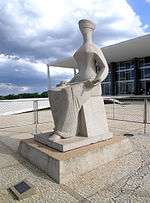 The Justice, in front of the Supreme Court of Brazil
The Justice, in front of the Supreme Court of Brazil Lady Justice seated at the entrance of The Palace of Justice, Rome, Italy
Lady Justice seated at the entrance of The Palace of Justice, Rome, Italy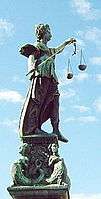 Sculpture of Lady Justice on the Gerechtigkeitsbrunnen (Frankfurt) in Frankfurt, Germany
Sculpture of Lady Justice on the Gerechtigkeitsbrunnen (Frankfurt) in Frankfurt, Germany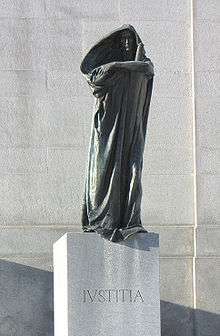 Justitia, outside the Supreme Court of Canada, Ottawa, Canada
Justitia, outside the Supreme Court of Canada, Ottawa, Canada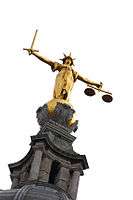 The Central Criminal Court or Old Bailey, London, UK
The Central Criminal Court or Old Bailey, London, UK Themis, Itojyuku, Shibuya-ku, Japan
Themis, Itojyuku, Shibuya-ku, Japan 19th-century sculpture of the Power of Law at Olomouc, Czech Republic—lacks the blindfold and scales of Justice, replacing the latter with a book
19th-century sculpture of the Power of Law at Olomouc, Czech Republic—lacks the blindfold and scales of Justice, replacing the latter with a book Themis, Chuo University, Tama-shi, Japan
Themis, Chuo University, Tama-shi, Japan Themis, Chuo University Suginami high school, Suginami-ku, Japan
Themis, Chuo University Suginami high school, Suginami-ku, Japan The Law, by Jean Feuchère
The Law, by Jean Feuchère Shelby County Courthouse, Memphis, Tennessee, United States
Shelby County Courthouse, Memphis, Tennessee, United States

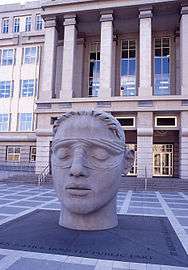
 Justitia in the Superior Courts Building in Budapest, Hungary
Justitia in the Superior Courts Building in Budapest, Hungary
- Justice in painting
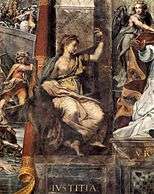 Fresco in the Sala di Costantino, Raphael Rooms, Raphael, circa 1520
Fresco in the Sala di Costantino, Raphael Rooms, Raphael, circa 1520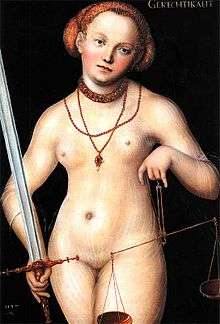 Gerechtigkeit, Lucas Cranach the Elder, 1537
Gerechtigkeit, Lucas Cranach the Elder, 1537 Luca Giordano, Palazzo Medici Riccardi in Florence, 1684–1686
Luca Giordano, Palazzo Medici Riccardi in Florence, 1684–1686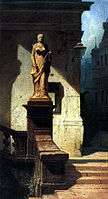 Justitia (Spitzweg), Carl Spitzweg, ca 1857
Justitia (Spitzweg), Carl Spitzweg, ca 1857
Lady Justice and her symbols are used in heraldry, especially in the arms of legal government agencies.
- Justice in heraldry
 Justitia in arms of Ilshofen in Baden-Württemberg
Justitia in arms of Ilshofen in Baden-Württemberg Scales and sword in the arms of a Swedish court of law
Scales and sword in the arms of a Swedish court of law
- Justice in numismatics
-%240.50-Fr.1355.jpg) Justice holding scales, $0.50 U.S. Fractional currency.
Justice holding scales, $0.50 U.S. Fractional currency.
See also
- (Goddesses of Justice): Astraea, Dike, Themis, Prudentia
- (Goddesses of Injustice): Adikia
- (Aspects of Justice): (see also: Triple goddess/Triple goddesses/Triple deity/Triple Goddess (neopaganism))
- (Justice) Themis/Dike/Justitia (Lady Justice), Raguel (the Angel of Justice)
- (Retribution) Nemesis/Rhamnousia/Rhamnusia/Adrasteia/Adrestia/Invidia
- (Redemption) Eleos/Soteria/Clementia, Zadkiel/Zachariel (the Angel of Mercy)
- Lady Luck
- Lady Liberty
References
- 1 2 "IUSTITIA". treccani.it.
- ↑ Hamilton, Marci. God vs. the Gavel, page 296 (Cambridge University Press 2005): "The symbol of the judicial system, seen in courtrooms throughout the United States, is blindfolded Lady Justice."
- ↑ Fabri,books.google.com/books?id=AwwH0F8iC9QC&pg=PA137&dq=%22lady+justice%22+symbol&lr=&as_brr=3&ei=uXb8Se-IC4GuyATlm5SPBg The challenge of change for judicial systems], page 137 (IOS Press 2000): "the judicial system is intended to be apolitical, its symbol being that of a blindfolded Lady Justice holding balanced scales."
- ↑ See "The Scales of Justice as Represented in Engravings, Emblems, Reliefs and Sculptures of Early Modern Europe" in G. Lamoine, ed., Images et representations de la justice du XVie au XIXe siecle (Toulouse: University of Toulose-Le Mirail, 1983)" at page 8.
- ↑ Image of Lady Justice in Berne.
- ↑ Image of Lady Justice in London.
- ↑ Colomb, Gregory. Designs on Truth, p. 50 (Penn State Press, 1992).
- ↑ Image of Lady Justice in Memphis.
External links
| Wikimedia Commons has media related to Iustitia. |
- DOJ Seal - History and Motto
- Origin of Lady of Justice
- Images of the Goddess of Justice
- Photos of Lady Justice
- ladyjusticesculpture.com